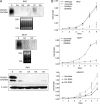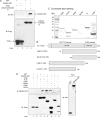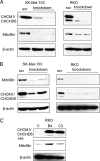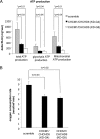CHCM1/CHCHD6, novel mitochondrial protein linked to regulation of mitofilin and mitochondrial cristae morphology
- PMID: 22228767
- PMCID: PMC3293568
- DOI: 10.1074/jbc.M111.277103
CHCM1/CHCHD6, novel mitochondrial protein linked to regulation of mitofilin and mitochondrial cristae morphology
Abstract
The structural integrity of mitochondrial cristae is crucial for mitochondrial functions; however, the molecular events controlling the structural integrity and biogenesis of mitochondrial cristae remain to be fully elucidated. Here, we report the functional characterization of a novel mitochondrial protein named CHCM1 (coiled coil helix cristae morphology 1)/CHCHD6. CHCM1/CHCHD6 harbors a coiled coil helix-coiled coil helix domain at its C-terminal end and predominantly localizes to mitochondrial inner membrane. CHCM1/CHCHD6 knockdown causes severe defects in mitochondrial cristae morphology. The mitochondrial cristae in CHCM1/CHCHD6-deficient cells become hollow with loss of structural definitions and reduction in electron-dense matrix. CHCM1/CHCHD6 depletion also leads to reductions in cell growth, ATP production, and oxygen consumption. CHCM1/CHCHD6 through its C-terminal end strongly and directly interacts with the mitochondrial inner membrane protein mitofilin, which is known to also control mitochondrial cristae morphology. CHCM1/CHCHD6 also interacts with other mitofilin-associated proteins, including DISC1 and CHCHD3. Knockdown of CHCM1/CHCHD6 reduces mitofilin protein levels; conversely, mitofilin knockdown leads to reduction in CHCM1 levels, suggesting coordinate regulation between these proteins. Our results further indicate that genotoxic anticancer drugs that induce DNA damage down-regulate CHCM1/CHCHD6 expression in multiple human cancer cells, whereas mitochondrial respiratory chain inhibitors do not affect CHCM1/CHCHD6 levels. CHCM1/CHCHD6 knockdown in human cancer cells enhances chemosensitivity to genotoxic anticancer drugs, whereas its overexpression increases resistance. Collectively, our results indicate that CHCM1/CHCHD6 is linked to regulation of mitochondrial cristae morphology, cell growth, ATP production, and oxygen consumption and highlight its potential as a possible target for cancer therapeutics.
Figures











Similar articles
-
Mitofilin and CHCHD6 physically interact with Sam50 to sustain cristae structure.Sci Rep. 2015 Nov 4;5:16064. doi: 10.1038/srep16064. Sci Rep. 2015. PMID: 26530328 Free PMC article.
-
Regulation of mitochondrial cristae remodelling by acetylcholine alleviates palmitate-induced cardiomyocyte hypertrophy.Free Radic Biol Med. 2019 Dec;145:103-117. doi: 10.1016/j.freeradbiomed.2019.09.025. Epub 2019 Sep 22. Free Radic Biol Med. 2019. PMID: 31553938
-
Role of MINOS in mitochondrial membrane architecture: cristae morphology and outer membrane interactions differentially depend on mitofilin domains.J Mol Biol. 2012 Sep 14;422(2):183-91. doi: 10.1016/j.jmb.2012.05.004. Epub 2012 May 7. J Mol Biol. 2012. PMID: 22575891
-
Novel intracellular functions of apolipoproteins: the ApoO protein family as constituents of the Mitofilin/MINOS complex determines cristae morphology in mitochondria.Biol Chem. 2014 Mar;395(3):285-96. doi: 10.1515/hsz-2013-0274. Biol Chem. 2014. PMID: 24391192 Review.
-
Mitochondrial inner membrane protein, Mic60/mitofilin in mammalian organ protection.J Cell Physiol. 2019 Apr;234(4):3383-3393. doi: 10.1002/jcp.27314. Epub 2018 Sep 14. J Cell Physiol. 2019. PMID: 30259514 Free PMC article. Review.
Cited by
-
3D reconstruction of murine mitochondria reveals changes in structure during aging linked to the MICOS complex.Aging Cell. 2023 Dec;22(12):e14009. doi: 10.1111/acel.14009. Epub 2023 Nov 13. Aging Cell. 2023. PMID: 37960952 Free PMC article.
-
CHTM1, a novel metabolic marker deregulated in human malignancies.Oncogene. 2018 Apr;37(15):2052-2066. doi: 10.1038/s41388-017-0051-9. Epub 2018 Jan 26. Oncogene. 2018. PMID: 29371680 Free PMC article.
-
Mitofilin and CHCHD6 physically interact with Sam50 to sustain cristae structure.Sci Rep. 2015 Nov 4;5:16064. doi: 10.1038/srep16064. Sci Rep. 2015. PMID: 26530328 Free PMC article.
-
Miro clusters regulate ER-mitochondria contact sites and link cristae organization to the mitochondrial transport machinery.Nat Commun. 2019 Sep 27;10(1):4399. doi: 10.1038/s41467-019-12382-4. Nat Commun. 2019. PMID: 31562315 Free PMC article.
-
Mendelian Randomization Analysis of Mitochondria-Related Genes and Screening of Prognostic Genes in Colorectal Cancer.Cancer Med. 2025 Jul;14(13):e71012. doi: 10.1002/cam4.71012. Cancer Med. 2025. PMID: 40620061 Free PMC article.
References
-
- Czarnecka A. M., Marino Gammazza A., Di Felice V., Zummo G., Cappello F. (2007) Cancer as a “Mitochondriopathy.” J. Cancer Mol. 3, 71–79
-
- Kirkinezos I. G., Moraes C. T. (2001) Reactive oxygen species and mitochondrial diseases. Semin. Cell Dev. Biol. 12, 449–457 - PubMed
-
- Toyokuni S., Okamoto K., Yodoi J., Hiai H. (1995) Persistent oxidative stress in cancer. FEBS Lett. 358, 1–3 - PubMed
-
- Warburg O. (1956) On the origin of cancer cells. Science 123, 309–314 - PubMed
Publication types
MeSH terms
Substances
Associated data
- Actions
Grants and funding
LinkOut - more resources
Full Text Sources
Other Literature Sources
Molecular Biology Databases

